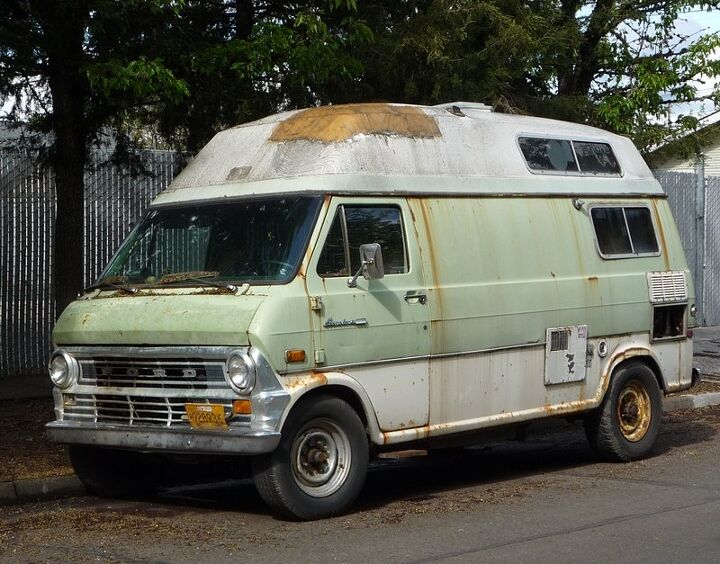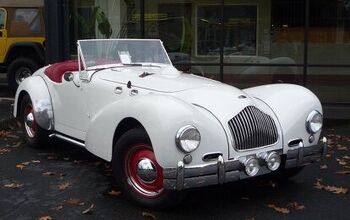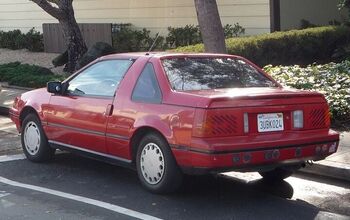Curbside Classic Outtake: Gen2 Econoline

EAW is either just a ploy for me to burn off some of my overflowing files of obscure cars I’ve shot, or to document the history of this storied vehicle. The gen2 Econolines don’t exactly get a lot of interest, and they’re rapidly disappearing from the street scape. There’s two places to find them still: in the parks, and on certain streets in industrial areas. They’ve become prime real estate for the wandering underclass. Everybody needs at least an Econoline to call “home”.
In 1968, Ford revolutionized the American van, by putting the engine up front, and making it essentially a full-sized vehicle, sharing as much as possible with the F-Series pickups rather than the Falcon. Two wheelbase versions were on tap: the one on top is the shorty, the one below is long, as well as someone’s permanent address. It’s been in this spot for years.
The extra width came in mighty handy, especially for sleeping. Now it was possible to stretch out sideways, rather than only longitudinally. No wonder these are so popular with “campers”.
Several years into their run, Ford also made a sliding side door optional. In another clever use of body symmetry, the rear doors also doubled as the side doors, in the non-sliding door versions. Don’t you feel gratified knowing that?
Power also included Ford’s small block V8s, in 289 and 302 versions. But the move to put the engine in front, and still keep the overall length as short as possible meant a serious compromise: the engine was shifted off-center, to the right, meaning that there was barely enough leg room to put two feet side-by-side for the shotgun position. When Chevy and Dodge introduced their new vans in 1971, the engines were a tad less intrusive, especially on the Chevy. Ford was determined to stay out front, literally, so the gen2 had a relatively short shelf life, 1968-1974.

More by Paul Niedermeyer
Latest Car Reviews
Read moreLatest Product Reviews
Read moreRecent Comments
- Brian Uchida Laguna Seca, corkscrew, (drying track off in rental car prior to Superbike test session), at speed - turn 9 big Willow Springs racing a motorcycle,- at greater speed (but riding shotgun) - The Carrousel at Sears Point in a 1981 PA9 Osella 2 litre FIA racer with Eddie Lawson at the wheel! (apologies for not being brief!)
- Mister It wasn't helped any by the horrible fuel economy for what it was... something like 22mpg city, iirc.
- Lorenzo I shop for all-season tires that have good wet and dry pavement grip and use them year-round. Nothing works on black ice, and I stopped driving in snow long ago - I'll wait until the streets and highways are plowed, when all-seasons are good enough. After all, I don't live in Canada or deep in the snow zone.
- FormerFF I’m in Atlanta. The summers go on in April and come off in October. I have a Cayman that stays on summer tires year round and gets driven on winter days when the temperature gets above 45 F and it’s dry, which is usually at least once a week.
- Kwik_Shift_Pro4X I've never driven anything that would justify having summer tires.





































Comments
Join the conversation
When I was 15, my then 24 year-old brother's friends from university came by to visit for a few days that summer. They were traveling across the country in a '69 Econoline with the almighty 250 cu. in. inline six. Having just met our family the day before, they apparently confused me with my then 21 year-old middle brother and invited me to join them in partaking of some South American smoking materials while tooling along in the Econoline. Once in the van, I realized that the engine was running very poorly. After we got back from our little excursion, and my head cleared up, I did some basic maintenance items, such as changing the air filter (it had a bird's feathers in it...) and cleaning and re-gapping the spark plugs. Once complete, the two travelers were so happy with my efforts, that they wanted to reward me with a large quantity of the aforementioned smoking materials. However, my oldest brother got wind of the offering, so to speak, and rapidly put the kibosh on the peace offering. However, they did make it up to me, with a crispy $20 bill (in 1978 that wasn't bad money for an hour's work). Who says you can't have fun with an old Econoline?
Back in the 70s, a friend's dad had a 69 base model Club Wagon. 6 cyl, 3 speed on the column, and the only non-metal material on the interior was on the dash pad and the seat upholstery. Side panels and floors were all painted steel. There was nothing luxurious about it, but it was durable. These were rusters in salt country, which might explain their low survival rate. Another interesting quirk that these had were that after a few years, you could always see the spotwelds over the rear wheel arches. Looked to me like body stresses pulled on this area, which exposed the arc of dimples, which would usually start to rust. These were groundbreaking in being the first to have a stubby hood out front to check fluids, but they were quickly leapfrogged by the 71 Dodge. Dodge owned this market for a few years until the legendary Chrysler quality of the 70s scared off most van buyers in time for the 75 Ford to hit the market.